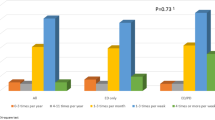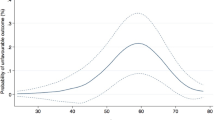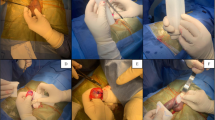Abstract
Immediate outcomes of surgery for Peyronie’s disease (PD) are fairly easy to analyze. However, it is the patient-reported long-term outcomes which eventually determine the success of PD treatment. The goal of this observational study was to evaluate patients’ satisfaction with results of surgical treatment for PD at long-term follow-up. The primary outcome was the proportion of patients who were completely satisfied with their erectile function and penile appearance. We retrospectively identified 374 patients who underwent surgery for PD (median follow-up: 9.5 years) and attempted to invite them for follow-up visit; 342 patients were available for follow-up. Only 285 (83.3%) were sexually active. Among all patients, 197 (57.6%) were completely satisfied with penile appearance; among sexually active patients, 139 (40.6%) were completely satisfied with their erections. Only 101 patients (29.5%) were completely satisfied with penile appearance and erectile function. Logistic regression analysis revealed preoperative IIEF-EF score (OR = 1.668 per 1 point; 95% CI 1.469–1.894), tunica albuginea plication (OR = 5.599; 95% CI = 1.014–30.92), use of saphenous vein (OR = 8.517; 95% CI = 2.491–29.115), and cadaveric pericardium (OR = 61.388; 95% CI = 7.674–491.11) as significant predictors of satisfaction with erectile function. Severity of curvature (OR = 0.926 per 5°; 95% CI = 0.907–0.946) and tunica plication (OR = 0.117; 95% CI = 0.019–0.738) were negative predictors of satisfaction with penile appearance. Preoperative IIEF-EF (OR = 1.497 per 1 point; 95% CI = 1.322–1.694), severity of penile curvature (OR = 0.967 per 5°; 95% CI = 0.95–0.983), and use of pericardium allograft (OR = 10.728; 95% CI = 1.363–84.46) were predictors of both endpoints (satisfaction with erectile function and cosmesis). Despite excellent surgical outcomes in PD, patients’ satisfaction with penile appearance and erectile function is far from absolute and depends on many patient-related and treatment-related factors.
This is a preview of subscription content, access via your institution
Access options
Subscribe to this journal
Receive 8 print issues and online access
$259.00 per year
only $32.38 per issue
Buy this article
- Purchase on Springer Link
- Instant access to full article PDF
Prices may be subject to local taxes which are calculated during checkout
Similar content being viewed by others
References
Chung E. Penile reconstructive surgery in Peyronie disease: challenges in restoring normal penis size, shape, and function. World J Mens Health. 2018;36:e10.
Krishnappa P, Fernandez-Pascual E, Carballido J, Moncada I, Lledo-Garcia E, Martinez-Salamanca JI. Surgical management of Peyronie’s disease with co-existent erectile dysfunction. Sex Med. 2019;7:361–70.
Chung E, Clendinning E, Lessard L, Brock G. Five-year follow-up of Peyronie’s graft surgery: outcomes and patient satisfaction. J Sex Med. 2011;8:594–600.
Morgado A, Morgado MR, Tomada N. Penile lengthening with porcine small intestinal submucosa grafting in Peyronie’s disease treatment: long‐term surgical outcomes, patients’ satisfaction and dissatisfaction predictors. Andrology. 2018;6:909–15.
Soave A, Laurich S, Dahlem R, Vetterlein MW, Engel O, Nieder T, et al. Negative self-perception and self-attitude of sexuality is a risk factor for patient dissatisfaction following penile surgery with small intestinal submucosa grafting for the treatment of severe Peyronie’s disease. J Clin Med. 2019;8:1121.
Hatzichristodoulou G, Osmonov D, Kübler H, Hellstrom WJG, Yafi FA. Contemporary review of grafting techniques for the surgical treatment of Peyronie’s disease. Sex Med Rev. 2017;5:544–52.
Ziegelmann MJ, Farrell MR, Levine LA. Modern treatment strategies for penile prosthetics in Peyronie’s disease: a contemporary clinical review. Asian J Androl. 2020;22:51–9.
Rice PG, Somani BK, Rees RW. Twenty years of plaque incision and grafting for Peyronie’s disease: a review of literature. Sex Med. 2019;7:115–28.
Chen J, Godschalk M, Katz PG, Mulligan T. Peyronie’s-like plaque after penile injection of prostaglandin E1. J Urol. 1994;152:961–2.
Chung E, Wang R, Ralph D, Levine L, Brock G. A worldwide survey on Peyronie’s disease surgical practice patterns among surgeons. J Sex Med. 2018;15:568–75.
Garcia-Gomez B, Ralph D, Levine L, Moncada-Iribarren I, Djinovic R, Albersen M, et al. Grafts for Peyronie’s disease: a comprehensive review. Andrology. 2018;6:117–26.
Khera M, Bella A, Karpman E, Brant W, Christine B, Kansas B, et al. Penile prosthesis implantation in patients with Peyronie’s disease: results of the PROPPER study demonstrates a decrease in patient-reported depression. J Sex Med. 2018;15:786–8.
Wallen JJ, Madiraju SK, Wang R, Henry GD. Implementation of length expanding inflatable penile prosthesis is not sufficient to prevent postsurgical penile shortening. Asian J Androl. 2019;21:98–100.
Al-Thakafi S, Al-Hathal N. Peyronie’s disease: a literature review on epidemiology, genetics, pathophysiology, diagnosis and work-up. Transl Androl Urol. 2016;5:280–9.
Reddy RS, McKibben MJ, Fuchs JS, Shakir N, Scott J, Morey AF. Plication for severe Peyronie’s deformities has similar long-term outcomes to milder cases. J Sex Med. 2018;15:1498–505.
Falcone M, Preto M, Ceruti C, Timpano M, Garaffa G, Sedigh O, et al. A comparative study between 2 different grafts used as patches after plaque incision and inflatable penile prosthesis implantation for end-stage Peyronie’s disease. J Sex Med. 2018;15:848–52.
Askari M, Mohamad Mirjalili SA, Bozorg M, Azizi R, Namiranian N. The prevalence of Peyronie’s disease in diabetic patients—2018—Yazd. Diabetes Metab Syndr. 2019;13:604–7.
Satyanarayan A, Singla N, Morey AF. Penile ossification: a reconstructive challenge. Rev Urol. 2017;19:64–7.
Dalkin BL, Carter MF. Venogenic impotence following dermal graft repair for Peyronie’s disease. J Urol. 1991;146:849–51.
Chow AK, Sidelsky SA, Levine LA. Surgical outcomes of plaque excision and grafting and supplemental tunica albuginea plication for treatment of Peyronie’s disease with severe compound curvature. J Sex Med. 2018;15:1021–9.
Mulhall J, Anderson M, Parker M. A surgical algorithm for men with combined Peyronie’s disease and erectile dysfunction: functional and satisfaction outcomes. J Sex Med. 2005;2:132–8.
Baldini A, Morel-Journel N, Paparel P, Ruffion A, Terrier JE. Patient-reported long-term sexual outcomes following plication surgery for penile curvature: a retrospective 58-patient study. Prog Urol. 2017;27:10–6.
Author information
Authors and Affiliations
Corresponding author
Ethics declarations
Conflict of interest
The authors declare that they have no conflict of interest.
Additional information
Publisher’s note Springer Nature remains neutral with regard to jurisdictional claims in published maps and institutional affiliations.
Rights and permissions
About this article
Cite this article
Gamidov, S., Shatylko, T., Gasanov, N. et al. Long-term outcomes of surgery for Peyronie’s disease: focus on patient satisfaction. Int J Impot Res 33, 332–338 (2021). https://doi.org/10.1038/s41443-020-0297-6
Received:
Revised:
Accepted:
Published:
Issue Date:
DOI: https://doi.org/10.1038/s41443-020-0297-6
This article is cited by
-
Insurance approval rates for collagenase clostridium histolyticum prior to discontinuation: a Canada-wide analysis
International Journal of Impotence Research (2023)
-
3D-printed phantoms to quantify accuracy and variability of goniometric and volumetric assessment of Peyronie’s disease deformities
International Journal of Impotence Research (2022)



